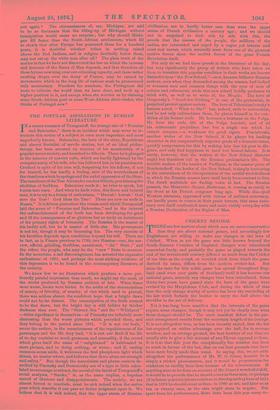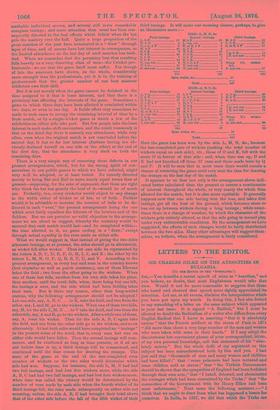CRICKET REFORM.
Yet it has long been manifest that the interests of the game require some changes, though it may not yet be clearly seen what those changes should be. The most manifest defect in the pre- sent arrangement results from the uncertain length of the innings. It is not altogether true, as has been recently stated, that the bat has acquired an undue advantage over the ball, for in average weather, and on average ground, the best bowlers of our time are usually able to give a fair account of any Eleven opposed to them. It is true that this year the exceptionally fine weather has been so much in favour of the bat, that on our best grounds runs have been more freely made than usual. In saying this, we set aside altogether the performances of Mr. W. G. Grace, because he is simply a cricket phenomenon, and it would be preposterous for cricketers to modify their laws because of his achievements. If anything were to be done on account of Mr. Grace's wonderful skill, it would be to provide that he should count as three men, or perhaps (if in future years his talents continue to develop as they have of late) that in 1878 he should count as four, in 1880 as six, and later on as ten or twenty men, as the case might seem to require. But apart from his performances, there have been this year many re- rnarkable individual scores, and several still more remarkable complete innings ; and more attention than usual has been con- sequently directed to the bad effects which follow when the bat gets the mastery over the ball. Quite a large proportion of the great matches of the year have terminated in a " draw " through lapse of time, and of course have lost interest in consequence, as the limited attendance on the last day of such matches has testi- fied. When we remember that the pecuniary loss thus resulting falls heavily on a very deserving class of men—the Cricket pro- fessionals—we see that the game itself must suffer. For though of late the amateurs have shown, on the whole, considerably more strength than the professionals, yet it is to the training of professionals that the greater number of our best amateur cricketers owe their skill.
But it is not merely when the game cannot be finished in the time assigned to it that it loses interest, and that there is a pecuniary loss affecting the interests of the game. Sometimes a game to which three days have been allotted is concluded within two days, or even in one day. A feeble effort may sometimes be made in such cases to occupy the remaining interval of time by a fresh match, or by a single-wicket game in which a few of the celebrities on either side take part. But few people take the least interest in such make-shift encounters, and the result commonly is that on the third day there is scarcely any attendance, while very often, even when the original match is not concluded before the second day, it has so far lost interest (fortune having too ob- viously declared herself on one side or the other) at the end of the first day, that the attendance is very slack on both the remaining days.
There is a very simple way of removing these defects in our present arrangements, which, but for the strong spirit of con- servatism in our public games to which we have referred, might very well be adopted, or at least tested. No remedy directed merely to bring Bat and Ball to more nearly equal terms than at present—supposing, for the sake of argument, that those are right who think the bat has greatly the best of it—would be of much use. Probably, too, every cricketer would object to any change in the width either of wicket or of bat, or of both. Neither would it be advisable to increase the number of balls to be de- livered in each "over," the present arrangement being the one which most fairly equalises the labours of the bowlers and of the fielders. But we can perceive no valid objection to the arrange- ment we are about to suggest, whereby the certainty would be secured that each match would last—and be completed within— the time allotted to it, no game ending in a "draw," except through actual equality in the runs made on either side.
What we would suggest is, that instead of giving the two sides alternate innings, as at present, the sides should go in alternately, as wicket fell after wicket. Thus let one side be represented by the letters A, B, C, D, E, F, G, H, I, J, and K; the other by the letters L, M, N, 0, P, Q, R, S, T, U, and V. According to the present arrangement, as every boy and man in the country knows (but virginibus as well as pueris cantamus), one of these Elevens takes the field ; two from the other going to the wickets. When one of these last falls, another from his own side takes his place, then another, until the tenth falls, when, there being but one left, the innings is over, and the side which had been fielding takes their turn. But is there any reason, other than long-settled custom, why the following arrangement should not be adopted ? Let one side, say, A, B, C . .. to K, take the field, and two from the other, say, L and M, go to the wickets. When one of these two falls, say, M, let the side L, M, N . to V take the field, and two from the other side, say, A and B, go to the wickets. After a while one of these, say, A, loses his wicket. Then let the side A, B, C again take the field, and one from the other side go to the wickets, and so on alternately. At last both sides would have completed an " innings " in the present sense of the word, that is, every man but one on either side would have fallen. Then the second innings will com- mence, and be continued as long as time permits, or if all are out before time is up, a third innings will be commenced, and continued until the time comes for drawing the stumps. The state of the game at the end of the last-completed even number of wickets on the two sides would determine which side had won. Suppose, for instance, the side L, M, N had had two full innings, and had lost five wickets more, while the side A, B, C had had two full innings, and had lost four wickets more, when time was called the victory would be determined by the number of runs made by each side when the fourth wicket of its third innings fell, the runs made subsequently on either side not counting, unless, the side A, B, C had brought their total above that of the other side before the fall of the fifth wicket of their
third innings. It will make our meaning clearer, perhaps, to give an illustrative score :—
First Innings.
L, b F 17 N, b G 2 D,oA,bF. 3 M, b F 41
Q, b E o
it, b F 31 S, b G 7 T, b F 14
II, run out a
V, b G 17 P, not out 54 — 171 SIDE—L, N, N, &cc. Second Innings.
M. b F 21 L, run out s
N, st B, b F 5 Q, b F 2 )1, b E 12 P, b 0 51 7 fi, b E 11 T,c0,bF 2 II, run out 5
V, not out 6
127 Third Innings M, b G ,, as L, b E 27 0,stB,bF 17
IQ, b E 11
P, no) out 78 'When O's wicket fell,
P, not out 57'
132 Byes, wides, Jsc 17 Total 447
SIDE—A, B, C, Sc.
Second Innings.
I, b V 0 A, b V 3 C, c P, b Q 7
D, b V o
F, b V 11
B, b V 31
J, b Q 10 0, b V 3 When K's wicket H, c P, b V 30 fell K, not out 2 D, not out 98 — —
87 90,
Byes, wides, Sc 19 Total 410
Here the game has been won by the side L, M, N, 8ce., because the last-completed pair of wickets (making the total number of wickets equal on each side), viz., those of 0 and K, fell with the score 37 in favour of that side ; and, when time was up, D and E had not knocked off these 37 runs and those made later by Q and P. It will be seen that in most cases there would remain a chance of retrieving the game until very near the time for drawing the stumps on the last day of the match.
It appears to us that not only is the arrangement above indi- cated better calculated than the present to ensure a continuance of interest throughout the whole, or very nearly the whole time allowed for the match, but it is also more equitable. It generally happens now that one side having won the toss, and taken first innings, get all the best of the ground, which becomes more or less cut up between wickets during a long innings ; while some- times there is a change of weather, by which the character of the wickets gets entirely altered, so that the side going in second play under very unfavourable conditions. By the arrangement we have suggested, the effects of such changes would be fairly distributed between the two sides. Many other advantages will suggest them- selves, we believe, when the arrangement is fairly considered.
First Innings.
A, b Q 21 C. b V la D, b Q 37 E, c B. b V 2 F, b V 7 B, b Q 69 11, st N, b L 13 0, run out 31 J, b Q 7 K, b V 13
I, not 001 21
214 Third Innings.
A,bQ. Kr B, b V 12 K, b Q 910.
D, not out 35 E, not out I 12



































 Previous page
Previous page